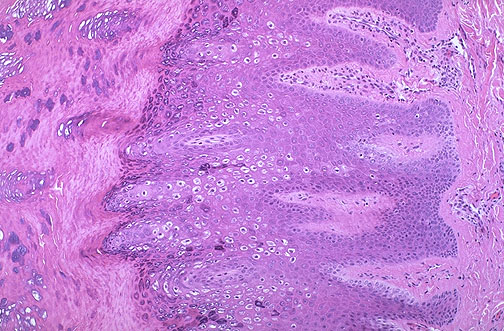|
A common wart, or verruca vulgaris, is shown here. There is epithelial hyperplasia marked by hyperkeratosis along with papillomatosis to produce the rough, warty gross appearance. The granular layer is prominent. These lesions are usually a few millimeters to 1 cm in size and are most often located on the hands. However, such lesions can also appear on the face (verruca plana), on the soles of the feet (verruca plantaris), or on the palms of the hands (verruca palmaris).
The verruca vulgaris demonstrates several key dermatopathologic terms:
Hyperkeratosis: excess keratin formation on the skin surface
Parakeratosis: Excessive keratin on the surface with pyknotic nuclei within
Acanthosis: increased thickness of the prickle layer of the epidermis, sometimes with increased keratohyaline granules
Spongiosis: intercellular edema of the epidermis
Papillomatosis: finger-like elongation of the rete ridges
Inclusion bodies: large intranuclear basophilic granules; cells with such viral inclusions are called koilocytes
Dyskeratosis: small intracytoplasmic, eosinophilic keratohyaline granules located below the corneal epidermal layer
|






